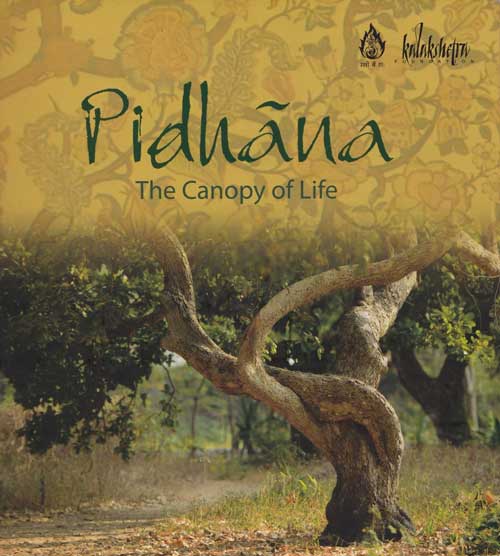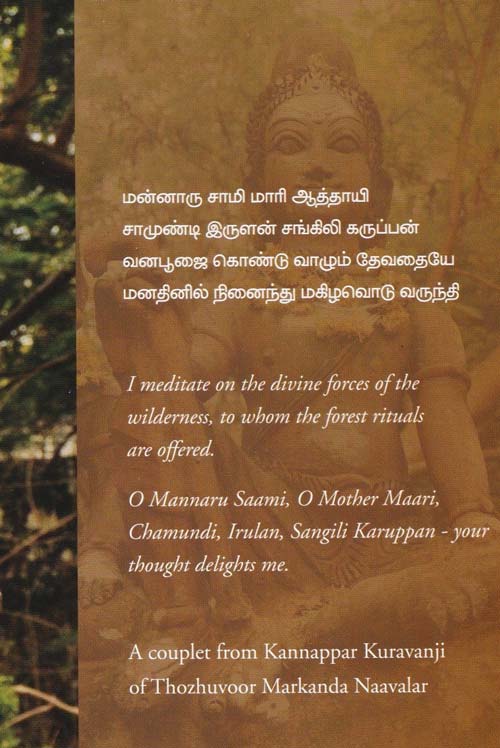

A Tamil couplet from Kannappar Kuravanji of Thozuvoor Markanda Naavalar
I meditate on the divine forces of the wilderness,
to whom the forest rituals are offered.
O Mannaru Saami, O Mother Maari,
Chamundi, Irulan, Sangile Karuppan –
Your though delights me.
Quoted from Pidhana – The Canopy of Life (Chennai, 2014, ISBN: 978-81-921627-3-7).
This richly illustrated publication tells the story of the trees found in the 99acre campus of Kalakshetra Foundation.
- copies are available at Kalakshetra’s office in Chennai >>
- learn more about Kalakshetra on its homepage kalakshetra.in >>
- contact the team behind this publication: http://nizhaltn.org/large_campuses.html >>
Source: Artiste Calls for Emulation of Kalakshetra’s Greenery – The New Indian Express
Address: http://www.newindianexpress.com/cities/chennai/Artiste-Calls-for-Emulation-of-Kalakshetras-Greenery/2014/09/17/article2434397.ece
Date Visited: Mon Mar 16 2015 22:43:25 GMT+0100 (CET)
AKILA KANNADASAN, The Hindu, December 16, 2014 | Read the full article here >>
The heritage walk around Kalakshetra mirrors the history and culture of the art foundation. […]
Under a banyan tree, an “offspring” of the one at Theosophical Society, where the institution for arts education was originally located, Apoorva Jayaraman, the project coordinator, narrates the story of Kalakshetra, a dream nurtured “by a young girl called Rukmini from Madurai”. […]
This is the starting point of the institution,” says Apoorva. The tree was the first to be planted in the 100-acre campus that’s now a teeming manmade forest. We walk through the tree-lined, leaves-strewn campus; listen to snatches of veena and mridangam from the classrooms; see students clad in cotton saris practise dance as a kingfisher flutters past their classroom window. Here, Nature, music, and dance co-exist. A Vishnu sculpture in stone, from Rukmini’s personal collection, stands under a tree, while a bust of Tagore occupies pride of place at the entrance of an L-shaped performance space called Tagore Hall.
“Tagore spent eight months teaching English at the institution when it was located at the campus of the Theosophical Society,” explains Apoorva. “Rukmini approached him when she was about to start Kalakshetra,” she adds. “Tagore was delighted to meet someone much younger than him with similar ideas.” The first structure to be constructed at the campus, the Hall stands in memory of Tagore’s stint at Kalakshetra. […]
Source: Another place, another time – The Hindu
Address: http://www.thehindu.com/features/metroplus/heritage-walk-around-kalakshetra/article6697596.ece
Date Visited: Mon Mar 16 2015 23:01:55 GMT+0100 (CET)
[Bold typeface added above for emphasis]
Kalakshetra was established in 1936 after the extraordinary success of Rukmini Devi’s first performance of Bharata Natyam at the Theosophical Society, in Adyar, a suburb of Madras, in the South of India. The founding members, Rukmini Devi, her husband George Arundale, and their associates at the Theosophical Society, were deeply committed to Theosophy and an arts academy was an extension of this commitment. The academy was also symbolic of the struggle for India’s independence; it was to culturally revive a country that was losing its identity under British rule. […]
In 1951, a sapling of the great banyan tree in the Theosophical Society’s grounds was planted at Tiruvanmiyur. The new campus was consolidated in the years that followed until it covered one hundred acres beside the sea. Gradually, other trees were planted on the sandy stretches of land. Kalakshetra moved to its new campus in the 1960s.
Source: Kalakshetra
Address: http://www.kalakshetra.in/history_4.html
Date Visited: Mon Mar 16 2015 22:58:21 GMT+0100 (CET)